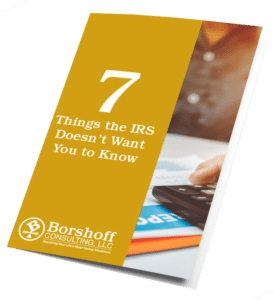The Child and Dependent Care Tax Credit is another great tax credit you should try to take advantage of (if you qualify). It was created to help working parents with expenses incurred for the care of a child or adult, as necessary for the dependent’s well being and safety.
There are some pretty extensive requirements regarding the type of expenses that qualify and the individual who receives the care, but we will go over them so that you can determine if your dependent qualifies for this tax credit.
What is the Child and Dependent Care Tax Credit?
The Child and Dependent Care Tax Credit is a tax credit that was created for parents who incur child care expenses while they were either at work or actively looking for work. Tax credits reduce tax liability by knocking the amount of tax due down on the tax return. This is different from a tax deduction, as a deduction only reduces your taxable income.
Who is allowed to claim the tax credit?
Child as the Qualifying Individual
To claim the Child and Dependent Care Tax Credit, you must file a tax return and have a qualifying individual who you paid eligible expenses for. The qualifying individual for this credit is a child under the age of 13.
For children of divorced or separated parents who live apart with one another, the noncustodial parent who claims the child as a dependent needs to read IRS Publication 503: Child and Dependent Care Expenses, specifically, the topic of “Child of Divorced or Separated Parents or Parents Living Apart.”
This is important because a child in this situation may be treated as a qualifying child of the custodial parent for this tax credit, even if the noncustodial parent is able to claim the child as a dependent. IRS Publication 503 sheds further light on this particular situation.
Spouse as the Qualifying Individual
Another qualifying individual who you could count would be your spouse, but this is only the case if he or she was physically or mentally incapable of self-care. To claim this credit, he or she would have to live with you for more than half of the tax year.
Disabled Person as the Qualifying Individual
If you had an individual who was physically or mentally incapable of self-care, who lived with you more than half of the tax year, and who you could have or did claim as a dependent, this person may be a qualifying person for the purposes of this tax credit.
To be classified as “physically or mentally incapable of self-care,” the individual must not be able to care for himself or herself. This means they have a physical or mental defect that has made the person incapable of caring for his or her hygiene or nutritional needs. This person also must require full-time assistance from another person for his or her own safety or the safety of others.
Other Requirements
You must have a Taxpayer Identification Number (TIN) to take the Child and Dependent Care Tax Credit. This is usually the Social Security number of each qualifying individual who you claim as a qualifying individual for this tax credit.
The best way to determine if you are eligible to claim the Child and Dependent Care Tax Credit is to check out the IRS’s Interactive Tool, Am I Eligible to Claim the Child and Dependent Care Credit?
How much is this tax credit worth?
The Child and Dependent Care Tax Credit is a percentage of your qualifying expenses up to $3,000 for one qualifying individual or $6,000 for more than one qualifying individual. The credit is actually the specified percentage of these amounts. This means you cannot get a tax credit of more than $6,000 if you are married.
The percentage of the Child and Dependent Care Tax Credit ranges from 20% to 35% of the amount you spent on care for the child or dependent up to the $3,000 (single) or $6,000 (joint) limits. The tax credit is also limited by your earned income and that of your spouse if filing a joint return.
The percentage that applies to your specific case depends on your adjusted gross income (AGI). For a full listing of the income amounts and percentage rates, see IRS Publication 503: Child and Dependent Care Expenses.
How does the tax credit work when filing your taxes?
The amount of the Child and Dependent Care Tax Credit is a percentage of the amount of expenses you incurred while working or looking for work. Only the expenses you paid to a qualified child care provider are applicable here. The percentage used to determine the tax credit depends on your adjusted gross income (AGI).
The total expenses you can use to calculate the credit may not be greater than $3,000 for a single individual or $6,000 for more than one individual. Also, the expenses must be necessary to ensure the individual’s well-being and protection. Having daycare for your child while you are at work or out looking for work would qualify as a necessary expense.
If you qualify for the Child and Dependent Care Tax Credit, you will need to complete IRS Form 2441: Child and Dependent Care Expenses. Then, when you file your tax return, usually IRS Form 1040, 1040-NR, or 1040-SR, you must attach IRS Form 2441 to it.
If you received qualifying dependent care benefits from your employer, you must complete Part III of IRS Form 2441. On your Form W-2: Wage and Tax Statement, which you should receive from your employer, it will show the amount of dependent care benefits provided by your employer.
What else should I know about this tax credit?
If you use the married filing separately (MFS) filing status, generally, according to the IRS, you cannot take the Child and Dependent Care Tax Credit. This means that using the right filing status is very important. If you are filing a joint return, generally, you are eligible for this tax credit.
For the exact details of this requirement, see IRS Publication 503: Child and Dependent Care Expenses, and refer to the section called “What’s Your Filing Status?” Your filing status is important for this tax credit. This publication explains the requirements for taxpayers who are separated from their spouses and other requirements.
To determine the amount of expenses paid for the care of a qualifying individual, you must only consider the expenses paid for care during the portion of the year that the individual was living with you if the dependent did not live with you all year.
Keep in mind that this tax credit is non-refundable, which means that you will not get a tax refund even if the credit is in excess of your tax liability.
You may be eligible for more tax credits for parents, so be sure to learn about them to see what you are qualified to take on your tax return!
Conclusion
Are you looking to claim the Child and Dependent Care Tax Credit on your next tax return? It may be a smart idea to enlist the help of a qualified tax consultant. He or she will know the tax rules and restrictions and can easily navigate between the forms you need to fill out.
If you are hoping to claim multiple tax credits, that can get a little complicated. You may want to hire a tax accountant to help in the preparation of your tax return.
At Borshoff Consulting, we can help with many things, including tax preparation, business consultations, and audit representation. Please contact us today for a free consultation; we know how to point you in the right direction when it comes to your taxes. You can trust Indiana’s tax expert!





